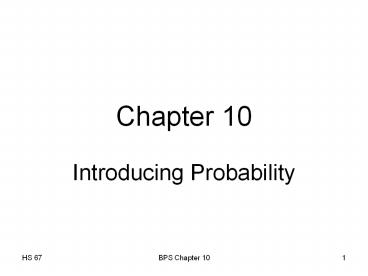Introducing Probability - PowerPoint PPT Presentation
Title:
Introducing Probability
Description:
To assign probabilities for continuous random variables density models ... Curve ... If I select a woman at random a 99.7% chance she is between 57' and 72' ... – PowerPoint PPT presentation
Number of Views:71
Avg rating:3.0/5.0
Title: Introducing Probability
1
Chapter 10
- Introducing Probability
2
Idea of Probability
- Probability is the science of chance behavior
- Chance behavior is unpredictable in the short
run, but is predictable in the long run - The probability of an event is its expected
proportion in an infinite series of repetitions
3
How Probability BehavesCoin Toss Example
Eventually, the proportion of heads approaches 0.5
4
How Probability BehavesRandom number table
example
The probability of a 0 in Table B is 1 in 10
(.10) Q What proportion of the first 50 digits
in Table B is a 0? A 3 of 50, or 0.06 Q
Shouldnt it be 0.10? A No. The run is too short
to determine probability. (Probability is the
proportion in an infinite series.)
5
Probability Models
- Probability models consist of two parts
- Sample Space (S) the set of all possible
outcomes of a random process. - Probabilities for each possible outcome in sample
space S are listed.
Probability Model toss a fair coin S Head,
Tail Pr(heads) 0.5 Pr(tails) 0.5
6
Rules of Probability
7
Rule 1 (Possible Probabilities)
- Let A event A
- 0 Pr(A) 1
- Probabilities are always between 0 and 1.
- Examples
- Pr(A) 0 means A never occurs
- Pr(A) 1 means A always occurs
- Pr(A) .25 means A occurs 25 of the time
8
Rule 2 (Sample Space)
- Let S the entire Sample Space
- Pr(S) 1
- All probabilities in the sample space together
must sum to 1 exactly. - Example Probability Model toss a fair coin,
shows that Pr(heads) Pr(tails) 0.5 0.5 1.0
9
Rule 3 (Complements)
- Let A the complement of event A
- Pr(A) 1 Pr(A)
- A complement of an event is its opposite
- For example
- Let A survival ? then A death
- If Pr(A) 0.95, then
- Pr(A) 1 0.95 0.05
10
Rule 4 (Disjoint events)
- Events A and B are disjoint if they are mutually
exclusive. When events are disjoint - Pr(A or B) Pr(A) Pr(B)
- Age of mother at first birth
- (A) under 20 25
- (B) 20-24 33
- (C) 25 42
Pr(B or C) 33 42 75
11
Discrete Random Variables
Discrete random variables address outcomes that
take on only discrete (integer) values
Example A couple wants three children. Let X
the number of girls they will have This
probability model is discrete
12
Continuous Random Variables
Continuous random variables form a continuum of
possible outcomes.
- Example Generate random number between 0 and 1 ?
infinite possibilities. - To assign probabilities for continuous random
variables ? density models (recall Ch 3)
13
Area Under Curve (AUC)
- The AUC concept (Chapter 3) is essential to
working with continuous random variables.
Example Select a number between 0 and 1 at
random. Let X the random value. Pr(X lt .5)
.5 Pr(X gt 0.8) .2
14
Normal Density Curves
Introduced in Ch 3 XN(µ, ?).
?
? Height XN(64.5, 2.5)
Standardized ZN(0, 1)
Z Scores
15
68-95-99.7 Rule
- Let X ? height (inches)
- X N (64.5, 2.5)
- Use 68-95-99.7 rule to determine heights for
99.7 of ? - µ 3s 64.5 3(2.5)
- 64.5 7.5 57 to 72
If I select a woman at random ? a 99.7 chance
she is between 57" and 72"
16
Calculating Normal Probabilities when 68-95-99.7
rule does not apply
- Recall 4 step procedure (Ch 3)
- A State
- B Standardize
- C Sketch
- D Table A
17
Illustration Normal Probabilities
What is the probability a woman is between 68
and 70 tall? Recall X N (64.5, 2.5)
A State We are looking for Pr(68 lt X lt 70)
B Standardize
Thus, Pr(68 lt X lt 70) Pr(1.4 lt Z lt 2.2)
18
Illustration (cont.)
C Sketch
D Table A Pr(1.4 lt Z lt 2.2) Pr(Z lt 2.2) -
Pr(Z lt 1.4) 0.9861 - 0.9192 0.0669






























![READ⚡[PDF]✔ Never a Dull Deal: Faith, Hope and Probability in Bridge PowerPoint PPT Presentation](https://s3.amazonaws.com/images.powershow.com/10052438.th0.jpg?_=202406101112)
![❤[PDF]⚡ The Mathematical Theory of Bridge: 134 Probability Tables, Their Uses, Simple PowerPoint PPT Presentation](https://s3.amazonaws.com/images.powershow.com/10085015.th0.jpg?_=202407240412)